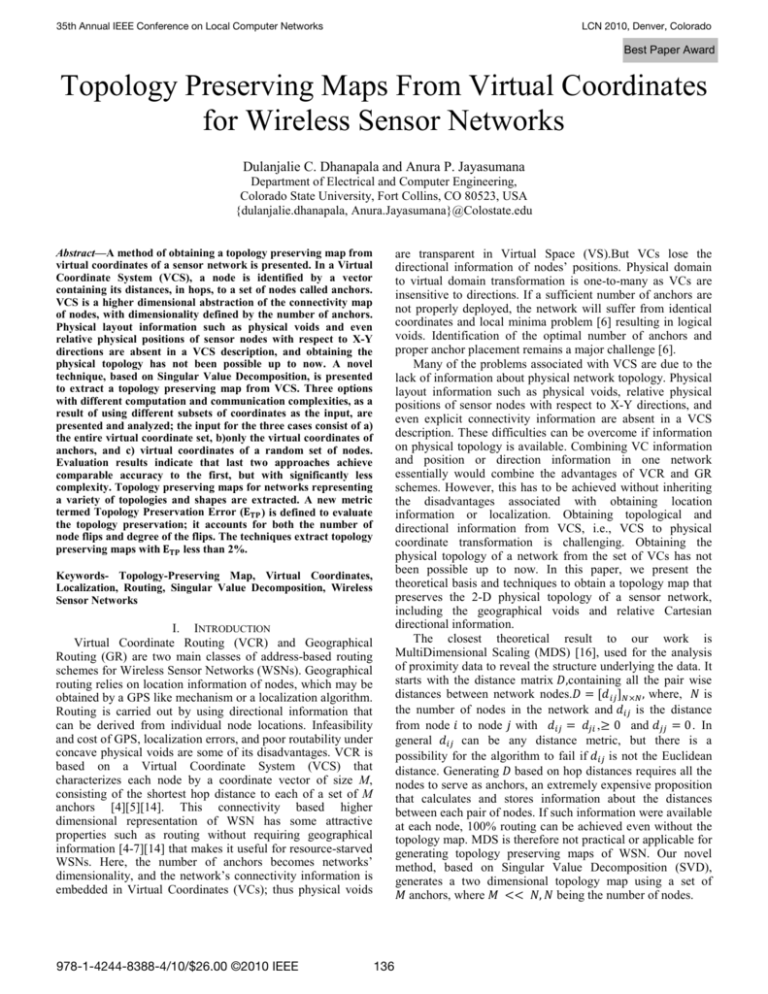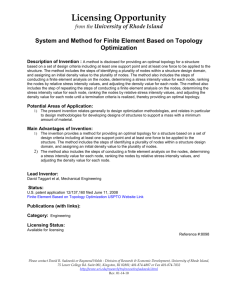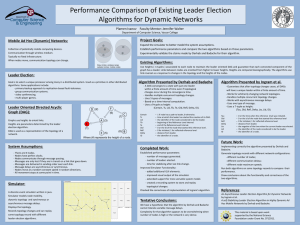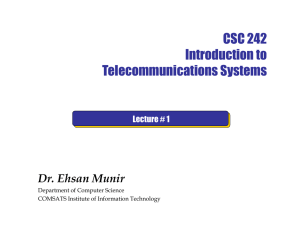Topology Preserving Maps From Virtual Coordinates for Wireless
advertisement

35th Annual IEEE Conference on Local Computer Networks
LCN 2010, Denver, Colorado
Best Paper Award
Topology Preserving Maps From Virtual Coordinates
for Wireless Sensor Networks
Dulanjalie C. Dhanapala and Anura P. Jayasumana
Department of Electrical and Computer Engineering,
Colorado State University, Fort Collins, CO 80523, USA
{dulanjalie.dhanapala, Anura.Jayasumana}@Colostate.edu
are transparent in Virtual Space (VS).But VCs lose the
directional information of nodes’ positions. Physical domain
to virtual domain transformation is one-to-many as VCs are
insensitive to directions. If a sufficient number of anchors are
not properly deployed, the network will suffer from identical
coordinates and local minima problem [6] resulting in logical
voids. Identification of the optimal number of anchors and
proper anchor placement remains a major challenge [6].
Many of the problems associated with VCS are due to the
lack of information about physical network topology. Physical
layout information such as physical voids, relative physical
positions of sensor nodes with respect to X-Y directions, and
even explicit connectivity information are absent in a VCS
description. These difficulties can be overcome if information
on physical topology is available. Combining VC information
and position or direction information in one network
essentially would combine the advantages of VCR and GR
schemes. However, this has to be achieved without inheriting
the disadvantages associated with obtaining location
information or localization. Obtaining topological and
directional information from VCS, i.e., VCS to physical
coordinate transformation is challenging. Obtaining the
physical topology of a network from the set of VCs has not
been possible up to now. In this paper, we present the
theoretical basis and techniques to obtain a topology map that
preserves the 2-D physical topology of a sensor network,
including the geographical voids and relative Cartesian
directional information.
The closest theoretical result to our work is
MultiDimensional Scaling (MDS) [16], used for the analysis
of proximity data to reveal the structure underlying the data. It
starts with the distance matrix ,containing all the pair wise
, where,
is
distances between network nodes.
is the distance
the number of nodes in the network and
, 0 and
0. In
from node to node with
general
can be any distance metric, but there is a
is not the Euclidean
possibility for the algorithm to fail if
distance. Generating based on hop distances requires all the
nodes to serve as anchors, an extremely expensive proposition
that calculates and stores information about the distances
between each pair of nodes. If such information were available
at each node, 100% routing can be achieved even without the
topology map. MDS is therefore not practical or applicable for
generating topology preserving maps of WSN. Our novel
method, based on Singular Value Decomposition (SVD),
generates a two dimensional topology map using a set of
anchors, where
, being the number of nodes.
Abstract—A method of obtaining a topology preserving map from
virtual coordinates of a sensor network is presented. In a Virtual
Coordinate System (VCS), a node is identified by a vector
containing its distances, in hops, to a set of nodes called anchors.
VCS is a higher dimensional abstraction of the connectivity map
of nodes, with dimensionality defined by the number of anchors.
Physical layout information such as physical voids and even
relative physical positions of sensor nodes with respect to X-Y
directions are absent in a VCS description, and obtaining the
physical topology has not been possible up to now. A novel
technique, based on Singular Value Decomposition, is presented
to extract a topology preserving map from VCS. Three options
with different computation and communication complexities, as a
result of using different subsets of coordinates as the input, are
presented and analyzed; the input for the three cases consist of a)
the entire virtual coordinate set, b)only the virtual coordinates of
anchors, and c) virtual coordinates of a random set of nodes.
Evaluation results indicate that last two approaches achieve
comparable accuracy to the first, but with significantly less
complexity. Topology preserving maps for networks representing
a variety of topologies and shapes are extracted. A new metric
termed Topology Preservation Error (
) is defined to evaluate
the topology preservation; it accounts for both the number of
node flips and degree of the flips. The techniques extract topology
preserving maps with
less than 2%.
Keywords- Topology-Preserving Map, Virtual Coordinates,
Localization, Routing, Singular Value Decomposition, Wireless
Sensor Networks
I. INTRODUCTION
Virtual Coordinate Routing (VCR) and Geographical
Routing (GR) are two main classes of address-based routing
schemes for Wireless Sensor Networks (WSNs). Geographical
routing relies on location information of nodes, which may be
obtained by a GPS like mechanism or a localization algorithm.
Routing is carried out by using directional information that
can be derived from individual node locations. Infeasibility
and cost of GPS, localization errors, and poor routability under
concave physical voids are some of its disadvantages. VCR is
based on a Virtual Coordinate System (VCS) that
characterizes each node by a coordinate vector of size M,
consisting of the shortest hop distance to each of a set of M
anchors [4][5][14]. This connectivity based higher
dimensional representation of WSN has some attractive
properties such as routing without requiring geographical
information [4-7][14] that makes it useful for resource-starved
WSNs. Here, the number of anchors becomes networks’
dimensionality, and the network’s connectivity information is
embedded in Virtual Coordinates (VCs); thus physical voids
978-1-4244-8388-4/10/$26.00 ©2010 IEEE
136
Topology preserving maps preserve the neighborhood
information but they have neither the exact coordinates nor the
relative distances compared to the original topology. These
maps are rotations, and/or translations from the real topology
of the network. With the information of geographical
locations, topology map can be used for localization as well.
WSN routing [1], boundary node identification for proper
anchor placements [4][5][14], backbone identification, and
identification of geographic voids, are among the examples
that can significantly benefit from a topology preserving map.
Topology preserving maps provide the ability to determine
and visualize the structural characteristics of a WSN.
Visualizing network infrastructure using VCS of the network,
which defines the node locations in a higher dimensional
space is extremely difficult except for trivial network
topologies. However, a topology preserving map, such as that
we are able to derive based on the proposed technique, would
provide a physical representation. It will facilitate network
design and network management processes by exposing
potential weaknesses in the infrastructure and opportunities to
improve its robustness and performance.
This paper presents techniques for obtaining topology
preserving maps of networks from VCS. Results presented
demonstrate that it is able to provide directional relationships
among nodes, and identify features such as physical voids and
network boundaries. Even though we focus on WSN context
here, the proposed technique is applicable to a broader class of
networks. After presenting the theoretical foundation for
obtaining the topology preserving map using the set of VCs,
we refine the method to reduce complexity. We demonstrate
that we can achieve almost as accurate topology maps by
using only the coordinates of the anchor nodes, or those of a
set or random nodes, thus significantly reducing the
computational and communication complexity. A novel
performance evaluation metric is proposed to capture the
percentage of node position flips due to the transformation,
and issued for evaluating the accuracy of the resulting
topology preserving maps.
Section II reviews the background, and Section III
discusses mapping nodes to Cartesian coordinates and thus a
topology preserving map. Section IV presents a performance
evaluation metric for topology maps and Section V presents
the results. Section VI addresses implementation issues.
Section VII presents conclusions and future work.
VCR examples include an algorithm which uses all the
perimeter nodes as anchors[14].When a message reaches a
local minimum, an expanding ring search is performed till a
closer node is found or TTL expires. In Virtual Coordinate
assignment protocol (VCap), the coordinates are defined based
on hop distances [4]. At local minima, VCR causes a packet to
follow a rule called local detour. In Logical Coordinate based
Routing (LCR) [5] backtracking is used when greedy
forwarding fails at a local minimum. Aligned virtual
coordinate system (AVCS) [13] reevaluates VCs by averaging
its own coordinate with neighboring coordinates to overcome
local minima. In Axis-based Virtual Coordinate Assignment
Protocol (ABVCap) [18], each node is assigned a 5-tuple VCs
corresponding to longitude, latitude, ripple, up, and down. All
the VCR protocols rely mainly on Greedy forwarding,
followed by a backtracking scheme to overcome the local
minima issue.
B. Localization [2][19]
Here we focus on relative localization techniques, as
global localization is realizable through relative localization
and the actual positions of a subset of nodes or anchors.
Centralized and distributed algorithms are available for
relative localization.
Distributed algorithms use Received Signal Strength
Indication (RSSI), Radio Hop Count, Time Difference of
Arrival and Angle of arrival for relative localization. RSSI
uses signal strength to estimate the distance between nodes
while. Radio Hop Count uses hop distance. Latter uses a
probabilistic correction equation to approximate the hop
distance to real distance [2].
Centralized algorithm has its own advantages [2]. Two
main centralized algorithms are SemiDefinite Programming
(SDP) and MDS-MAP. Former algorithm develops geometric
constraints between nodes and represented as linear matrix
inequalities (LMIs) then simply solve for the intersection of
the constraints. Unfortunately, not all geometric constraints
can be expressed as LMIs, which preclude the algorithm’s use
in practice. MDS-MAP is Multidimensional scaling based on
pair-wise distances measured using RSSI [2].
C. Localization Vs Topology Preserving Maps
Topology preserving maps discussed in this paper deviates
from the localization. The relative localization schemes expect
the relative distances to be accurate. Thus given the absolute
position of a subset of nodes, global localization is realizable.
In contrast, in topology maps what is important is the topology
preservation, not the node distances. The derived topology
should be homeomorphic (topologically isomorphic) to the
physical layout of the sensor network, i.e., between two
topological spaces there has to be a continuous inverse
function. In our case, a mapping preserves the topological
properties of the physical network topology. However, this
does not preclude the transformation of the topology
preservation map to obtain node localization.
II. BACKGROUND
A. Geographic Routing (GR) and Virtual Coordinate
Routing(VCR)
In Geographic Routing, the physical location of nodes is
used for addressing of the node as well as for routing. Greedy
Perimeter Stateless Routing (GPSR) [9] makes greedy
forwarding decisions until it fails, for example due to a
geographical void, and attempts to recover by routing around
the perimeter of the void. The Greedy Other Adaptive Face
Routing (GOAFR) [11], is a geometric ad-hoc algorithm
combining greedy forwarding and face routing to overcome
the local minima issue. Greedy Path Vector Face Routing with
Path Vector Exchange GPVFR/PVEX [12] is similar to [11]
but it uses more information about the planar graph.
III. CARTESIAN COORDINATES AND TOPOLOGY MAPS
This section presents a novel technique for obtaining a
Cartesian coordinate based map of a sensor network from its
VC set. The objective is to characterize each node with a
137
, coordinate pair, resulting in a topology preserving map
that is homeomorphic to the networks physical layout, and
preserves information about node connectivity, physical layout
and physical voids.
Subsection A develops the technique by starting with the
VCs of all the nodes to obtain the Cartesian coordinates of the
nodes, which collectively result in a topology preserving map.
In Subsection B, we present a significantly more efficient
version of the technique that uses information of only a small
subset of nodes to evaluate the transformation matrix. The
technique is illustrated using 1) the set of anchor nodes, and 2)
a random set of nodes, as the selected subset. Finally,
Subsection C proposes a method of calculating node’s
Cartesian coordinate with lower computational complexity.
A. 2-D topology preserving map from VCs
Consider a sensor network with nodes and anchors.
Thus each node is characterized by -length VC vector. Let
be the
matrix containing the VCs of all the nodes, i.e.,
the ith row corresponds to the - length VC vector of the ith
node, and jth column corresponds to the virtual ordinate of all
the nodes in the network with respect to jth anchor. Since only
a small set of nodes are anchors,
. Denote the
Singular Value Decomposition (SVD) [10] of as
. .
(1)
where, , and are
,
, and
matrices
respectively. and are unitary matrices, i.e.,
and
. SVD extracts and packages the salient
characteristics of the dataset providing an optimal basis for
. Moreover is an optimal basis of
.i.e. spans
.
Then, . gives the coordinates for the data under the new
basis . Since is a diagonal matrix, where diagonal elements
are the singular values arranged in their descending order,
elements in
provides unequal weights on columns of
.Therefore,
·
(2)
is a
matrix that describes each node with a
new set of -length coordinate vectors. Using the unitary
property of , it can be seen that it is the projection of on to
, i.e.,
·
(3)
The columns of
are arranged in the descending order
of information about the original coordinate set. With many
SVD based analyses, the first component contains the most
important and discriminating information and is indispensable.
However, as we show below, the second and third components
are more important for the generation of topology preserving
maps.
First seven ordinates given by Eq. (3) are plotted against
the corresponding physical positions of the nodes for the
networks shown in Fig. 1 (a) and 2 (a). As we observed (See
Fig. 1 and 2) initial triplet of SVD coordinates are the
dominating coordinates while the rest are similar to Fourier
basis vectors with less significant amplitudes.
The set of VCs have the connectivity information
embedded in it though it loses directional information. All the
nodes that are hops away from the jth anchor have as the jth
ordinate. Every ordinate propagates as concentric circles
Figure 1.a) Circular network of 707 nodes and b)-h) First eight SVD
coordinate vectors plotted against the physical positions.
centered at the corresponding anchor, while the angular
information is completely lost. Thus, we can expect the most
significant ordinate based on SVD, i.e., first column of
to
contain radial information, which will not give us enough
information to identify nodes distinctly (See Fig. 1 (b)) and
Fig. 2 (b)). As SVD provides an orthonormal basis, 2nd and 3rd
ordinates are orthogonal to 1st ordinate while being
perpendicular to each other as illustrated in Fig. 3. This leads
to the fact that the second and third columns of
provide a
set of 2-dimensional Cartesian coordinates for node positions.
Thus instead of the
coordinates of a row of
to
characterize a node, the second and third columns can be used
as Cartesian coordinates, i.e.,
,
,
(4)
,(j=2,3), is the jth column of
and
where
,
is the Cartesian coordinate matrix of the entire
node set, i.e., its ith row,
, ,
, , is considered to be the
Cartesian coordinates of ith node, Therefore by construction of
SVD coordinates, we assert that the second and third basis
vectors form an orthogonal Cartesian plane for the network
and corresponding ordinates gives us approximated Cartesian
coordinates (Eq. (4)). Most fascinating is the fact that these
Cartesian coordinates are estimated without having any kind
of physical directional or positioning information beyond the
radial information (hop distance) with respect to the anchors.
138
matrix
with much smaller subset of data of , thus
significantly reducing the computation overhead.
Let be a subset of the node coordinate set. Then we can
write the SVD of as,
· ·
(5)
is a basis for
. Similarly is also a basis of
.
Therefore, we can write
·
(6)
Where is a rotation matrix.
We consider two options for selecting the subset of nodes
is as described below.
for computing
1) Use the set of coordinates of the anchor nodes
( = )
Then, , and
of Eq. (5) are
matrices, where
and
are unitary matrices. Note that has the same size
as in Eq. (1). Following the same procedure as earlier
·
(7)
The approximated Cartesian coordinates can be written as
,
,
(8)
,
is the new Cartesian coordinate set of the network
,
is the Cartesian coordinate of ith
where ith row of
node.
)
2) Use a set of randomly selected nodes (
For
nodes Q R is R M , where M is the number of
anchors. SVD of Q R is evaluated as similar to Eq. (5). Eq. (7)
and (8) are valid except sizes of
and
are
and
respectively.
and
are thus
and
matrices,
In sum,
containing subsets of M and R rows of respectively, with
, .
Figure 2.b) Odd shaped network with 550 nodes, and b)-h) First eight SVD
coordinate vectors plotted against the physical positions.
C. An alternative computationally efficient approach
Computational power and memory available at a node is
limited. Conventional SVD calculation of
,
,
which involves computing , and , has approximately
4
8
9
operations [8]. In addition, the
memory requirement is approximately the sizes of , and
that is (
). In this section, we present
a technique for enhancing the efficiency of the computation.
Note that is a byproduct of SVD, and is not necessary for
topology map computation. From Eq. (1), (3) and (4),
Level sets of
ordinates with
respect to
Figure 3.Three main directions from SVD.
The topology preserving map thus obtained reflects the
original topological characteristics of the network. One can
even identify features such as physical voids that were not
apparent in the VC based description.
, ,
th
·
(9)
th
,
is the i row
, , is the ( , ) element of
of . This can be interpreted as the coordinate vector of the
is the jth basis vector/column of .
node i. Also
·
,
, ,
,
·
and
are sufficient to evaluate Cartesian
Thus,
as
coordinate of
, ,
, of node i. Define
.
. .
.
(10)
B. Generation of Cartesian coordinate set using VCs of
a subset of nodes
Cartesian coordinates can be obtained by multiplying the
node’s VC by as in Eq. (3) and (4). is evaluated based on
which is a
matrix that consists of VCs of entire
network. With sensor networks, it is crucial to reduce
communication and computation overheads involved. This
section presents a process to generate the transformation
139
Consider as an example, a 1-D network with 6 nodes
numbered 1 to 6 as in Fig. 4(a). Figs 4(b) and (c) show two
derived maps that need to be evaluated. If all the nodes are in
same order as in initial topology then neighborhood
preservation error has to be 0%. Node 3 in Fig. 4 (b) has
flipped two node positions. The error metric should identify
the number of out of order nodes as well as the degree of the
error/node flips (one node and two node positions respectively
for Fig. 4 (b)).
nodes and define an
Consider a 1-D network with
indicator function , where
1
,
0
,
1
Then, Number of out of order pairs = ∑ , I ,
The total number of possible pairs in an
node network
is P . We define the following metric:
is a
matrix. This is an eigenvalue problem [10].
There for let us solve
, where is an eigenvector of
that is a column of . Eigen values can be found by solving
0
(11)
s are the eigenvalues. The eigenvectors corresponding to
second and third largest eigenvalues provides the second and
third columns of . Now
can be evaluated
, ,
,
is not
locally without calculating entire . Also
evaluated at all, which reduces the memory consumption
significantly. Therefore, the memory consumption is upper
. , then memory
bounded by
). If
consumption is upper bounded by 2
.
Number of computations required in the proposed method
[8],
of calculating
is upper bounded by 4
8
which is the computations associated with calculation of entire
and . As
for the WSN applications, this method is
significantly less complex compared to full SVD
implementation (See Table I). For example, if the number of
anchors in the network is set to
0.01 , the upper bound
of computations with this method is only 0.99% of the
computations required for a full SVD based calculation with
Eq. (3) and (4) ,indicating a significant complexity reduction.
TABLE I.
Method
#
Computations
N M
Memory
usage
Topology Preservation Error
∑
, I,
(12)
PN
For the network in Fig. 4 (b), N =6 and:
ETP
I
I
,
I
,
,
I
I
,
I
,
,
/P
100%
/C
100%
13.3%
Node 1 and 2 are in right position compared to the rest
while node 3 is shifted by 2 positions. Moreover, nodes 4 and
5 flipped their positions by 1. Therefore total node flips are 4
and ETP is 13.3%
A topology preserving map is invariant to rotations. Thus,
for Fig.4 (c), where nodes are just reversed, ETP should be
zero.To handle such cases, the two lines being compared need
to be adjusted for any rotations.
COMUTATIONAL COMPLEXITY AND MEMORY USAGE
COMPARISION
Full SVD
Proposed method of
implementation
estimating
4
8
4
[8]
9
8
[8]
)
ETP
)
(a)
IV. A METRIC FOR EVALUATING TOPOLOGY PRESERVATION
Evaluating the accuracy of topology preservation of the
sensor node map generated using estimated Cartesian
coordinates (See Eq. (4)) is essential for investigating the
effectiveness of the proposed scheme. While visual inspection
can provide preliminary evidence of its effectiveness, a formal
metric is needed for quantifying the accuracy. A quantitative
parameter to express the error provides a framework to
compare and improve different mapping techniques. An
effective metric should be able to capture and quantify the
failures to preserve the topology of the real node map and the
neighborhoods. Here we develop a metric that can be used for
this purpose.
A method based on coloring of nodes is used in [15] to
show whether a neighborhood has been altered in the topology
map. In [15] and [17], error is quantified as the difference of
the positions in the real map and the topology map, and the
residual variance, respectively. The focus of our paper is
topology preserving maps based on hop distances. The
,
set is
requirement is that the map from calculated
homeomorphic to the physical layout, and preserves
information about node connectivity, physical layout and
physical voids. Thus the actual physical distance is not of
significance, and the metrics in [15] and [17] are not
appropriate.
1
1
2
3
4
3
5
4
2
5
6
6
(b)
6
5
4
3
2
1
(c)
Figure 4. Original layout (a) and two example topology maps (b), (c)
To extend the 1-D equation to 2-D topologies, we evaluate
the 2-D topology by considering all contiguous line segments
in two orthogonal directions (say and ) of the physical
map. Let us assume there are H lines in direction and V lines
in direction in the network, then,
Topology Preservation Error in
ETP|H
direction %
∑H ∑
∑H P
, I,
N
(13)
, are nodes in each horizontal line and each line has
nodes. Similarly, error in vertical direction is evaluated as
Topology Preservation Error in
ETP|V
∑V ∑
∑V P
direction %
, I,
N
(14)
, are nodes in each vertical line and each has
nodes. The
overall Topology Preservation Error can be defined as:
ETP
140
∑V ∑
, I,
N
∑H P
∑H ∑
∑V P
N
, I,
(15)
V. RESULTS
The performance of the proposed methods are evaluated
next using four examples representative oof a variety of
networks: a uniformly distributed circular nnetwork with 707
nodes (Fig. 5), an odd shaped network with 5550 nodes (Fig. 6),
a 496-node circular shaped network withh three physical
voids/holes (Fig. 7), and a network of 343 noodes mounted on
walls of a building (Fig. 8). Figure identified as (a) in Fig. 5-8
show the physical maps of the four casses respectively.
Communication range of a node in all four nnetworks is unity.
MATLAB® 2009b was used for the computaations. Topology
maps are generated based on methods summarrized in Table II.
Unless otherwise indicated, the results shhown correspond
to fifteen randomly placed anchors in each of the networks.
Fig. 5-8 (b) is the topology preserving map cconstructed based
on Eq. (4) using entire VC set of each nettwork. Therefore
Networks in Fig. 5-8(b) uses input data m
matrices of sizes
707x15, 550x15, 496x15 and 343x3 resspectively (Case
1,Table II). Then Fig. 5-8 (c) are the topoloogy maps created
using anchors’ coordinate set, that is using Eq. (7) and (8)
based on the input data matrices of size 15x115, 15x15, 15x15
and 3x 3 respectively (Case 2,Table II). Topollogy maps in Fig.
5-8 (d) are created on coordinates of 10 raandomly selected
nodes of sizes 10x15, 10x15, 10x15 and 10xx 3(Case 3,Table
II).Finally, Fig 5-8 (e) assumes all the nodes in the network
are anchors and generate VCSs of sizes 7077x707, 550x550,
496x496 and 343x343for corresponding nettwork. Then use
that VC set for topology map generation (C
Case 4, Table II).
Case 3 is more efficient in terms of memory cconsumption and
computational complexity.
TABLE II.
FOUR DIFFERENT TOPOLOGY MAPP GENERATION
APPROACHES FOR WSNS OF N NODES AND M ANCHORS
Input data
Case
Description (Eq. (4))
matrix
size
,
,
1
2
Figure 5.(a) Circular network,
,
is generated based on (b) Case
1:entire VC set,(c) Case 2: anchors’ coordinaate set(d) Case 3:randomly selected
nodes’ coordinate set (e) Case 4: coordinate set
s when all the nodes are anchors.
is generated based on entire VC set
is generated based on anchors’ VC
set
3
4
,
is generated based on randomly
selected nodes’ VC set
,
is generated based on VC set when
all the nodes are anchors
lower number of anchors, can produce more accurate,
dimensionally scaled network. Tho
ough the latter was not our
goal, it points to the possibility off obtaining even physically
representative layout maps with app
propriate selection of anchor
nodes. Transformation to mitigate the
t deformations and effect
of better anchor placement in topology
t
maps are under
investigation. The physical voids present in Fig. 8 are well
preserved. Even though the map in
i Fig. 8 (e) was obtained
using all the nodes as anchors its sh
hape is deformed compared
to Fig. 8 (b)-(d), but in terms of neig
ghborhood preservation Fig.
8 (e) is better. For example, one off the L-shaped rooms in the
building network (Fig. 8 (a)) is disttorted in the topology maps
of Fig. 8 (b)-(d). In Fig. 8 (e) thee L-shape is deformed but
neighborhood of that L-shaped room
m is preserved.
Topology Preservation Errors (Eq. (15)) for the four different
ks in Fig. 5-8 are presented
topology maps of the four network
in Table III. Note that the error in all
a the cases is less than 2%.
The best performance in terms of Topology
T
Preservation Error
was achieved when all the nodes were
w
selected as anchors for
the networks in Fig. 5-8. Case 4 (Table II) acts as a lower
bound for the Topology Preservation Error for each network.
A key observation we can draw from Figg. 5-7 is that the
constructed topology maps are nonlinearly sccaled and rotated
compared to the actual network map. Yet, the original and
constructed maps are topologically isomorphhic. Starting just
with VCs, without explicit knowledge of geographical
information, the generated topology mapss have captured
significant features such as the physical voidds of the original
network.
In contrast to previous cases, the topologyy maps of Fig. 8
(b), (c), (d) are simply a rotated and linear sscaled version of
the original. In this network, we used onlyy three anchors.
Moreover, from Fig. 8 topology maps we cann draw a valuable
conclusion that we can significantly reducee the number of
anchors required for topology map generaation with good
anchor placement. It is topology preservingg to a very high
degree as intended. The closeness in shape of Fig. 8(b)-(d) to
the original however indicate that an appropriaately placed
141
Figure 7. a) Circular network with threee physical voids;
,
is
generated based on (b) Case 1; entire VC set,,(c) Case 2: anchors’ coordinate set
(d) Case 3: randomly selected nodes’ coordiinate set (e) Case 4: coordinate set
when all the nodes arre anchors.
Figure 6. a) Odd shaped network;
,
is gennerated based on (b)
Case 1; entire VC set,(c) Case 2: anchors’ coordinate set, (d) Case 3: randomly
when all the nodes are
selected nodes’ coordinate set, (e) Case 4: coordinate set w
anchors.
implementation is feasible or eveen preferable. Consider a
sensor network where the nodes arre randomly deployed (e.g.,
dropped from a plane), and it is neecessary to obtain a map of
the sensor node deployment indicatiing geographic voids etc. In
this case, each node may send inforrmation about its neighbors
to a base or a central station. The adjacency
a
matrix [20] of the
network is formed based on the network
n
node connectivity
information, which can be gathereed with the complexity of
where N is the number of nodes
n
in the network. Now
the above procedures (Section IIII) can be used to get a
topology preserving map. If neccessary, the map can be
broadcast back to the individual nodes, together with the
transformation matrix ( or ), an operation of complexity of
. Generating coordinates at
a a central station avoids
multiple flooding in the network [4][5][14][18].
n of the above may be
A distributed implementation
achieved as follows. The anchor baased VC generation is first
carried out the traditional way, i.e., via flooding [1]. Following
that, the Anchors broadcast their coordinates,
c
which requires
messages. Now that the array
a
of all the anchors’
coordinates is available at each nod
de, each node i can generate
. (7)) and evaluate its own
n
locally by
, ,
,
simply multiplying its own coordinaate by .
Even though SVD based coordinate generaation started with
VC set where there is no directionality inforrmation, resultant
topology map has directional information whhich can be used
for routing in many ways for example to identtify logical voids
in VC routing, organized random routing and geographic
routing in VS.
VI.
REALIZATIONS OF THE ALGO
ORITHM
In this section, we consider the realization off the algorithm in
wireless sensor networks. As the major conntribution of this
paper is the technique described and evaluuated above for
generation of topology preserving map and thhe associated set
of Cartesian coordinates, the details of realization are
addressed only briefly. In static WSNs, thee VC generation
needs to be done very infrequently or perrhaps only once
during initialization. If a set of Cartesiann coordinates is
required, it needs to be done only once as weell. Thus, the cost
incurred in calculating Cartesian coordinatees may be more
than compensated by efficiency gains duuring long-term
operation.
First, consider the case where the computaation is done at a
central node. There are many scenarios where a centralized
142
coordinates and the topology map to improve routability are
under investigation.
ACKNOWLEDGEMENTS
This research is supported in part by NSF Grant CNS0720889.
REFERENCES
[1]
[2]
[3]
[4]
[5]
[6]
[7]
Figure 8. a) Network in a building;
,
is generated based on (b)
Case 1; entire VC set,(c) Case 2: anchors’ coordinate set (d) Case 3: randomly
selected nodes’ coordinate set (e) Case 4: coordinate set when all the nodes are
anchors.
TABLE III.
Figure
Fig.5
Fig.6
Fig.7
Fig.8
[8]
[9]
TOPOLOGY PRESERVATION ERROR FOR TOPOLOGY MAPS IN
FIG. 5-8
Case 1
0.9036
1.6777
0.3605
0.1315
Case 2
0.8346
1.5894
1.0698
0.1315
(%)
Case 3
0.2130
1.5011
0.4884
0.1315
[10]
Case 4
0
1.4570
0
0.0376
[11]
[12]
[13]
VII. CONCLUSIONS AND FUTURE WORK
We presented a novel and a fundamental technique for
generating a topology preserving map from virtual
coordinates. As demonstrated, the transformation matrix for
converting the logical coordinates to a set of approximate
Cartesian coordinates can be obtained using the coordinates of
a small set of nodes. Results show that a topology preservation
error (ETP ) ≤ 2% is achievable.
Applications of topology preserving maps are diverse and
vast: e.g., routing, localization, boundary node identification
or improve anchor placement. Having VCs as well as
approximate Cartesian coordinates (which can now be derived
from VCs) can significantly enhance the routing mechanisms.
Proposed SVD based approximated Cartesian coordinate
generation method has many significant applications in WSNs
as well as in general networks.
Methods to compensate for the compression of the map at
the edges, and techniques that use derived Cartesian
[14]
[15]
[16]
[17]
[18]
[19]
[20]
143
J.N. Al-Karaki, and A.E. Kamal, “Routing techniques in wireless sensor
networks: a survey,” IEEE Wireless Communications, Vol. 11, pp.6-28,
Dec. 2004.
J. Bachrach and C. Taylor, "Localization in sensor networks," Ch. 9,
Handbook of Sensor Networks, Stojmenovic (Editor), John Wiley 2005.
H. Balakrishnan, R. Baliga, D. Curtis, M. Goraczko, A. Miu, B.
Priyantha, A. Smith, K. Steele, S. Teller, and K. Wang, “Lessons from
developing and deploying the cricket indoor location system,” in MIT
Technical Report, Nov. 2003.
A. Caruso, S. Chessa, S. De, and A. Urpi, “GPS free coordinate
assignment and routing in wireless sensor networks,” Proc. 24th IEEE
Joint Conf. of Computer and Communications Societies, Vol. 1, pp. 150160, Mar. 2005.
Q. Cao and T Abdelzaher, “Scalable logical coordinates framework for
routing in wireless sensor networks,” ACM Transactions on Sensor
Networks,Vol. 2,pp. 557-593, Nov 2006.
D.C. Dhanapala, “On performance of random routing and virtual
coordinate based routing in WSNs”, M.S. Thesis, Colorado State
University, Fort Collins,CO, USA, 2009.
D. C. Dhanapala and A. P. Jayasumana, "CSR: convex subspace routing
protocol for WSNs," Proc. 33rd IEEE Conf. on Local Computer
Networks, Oct. 2009.
R. Hartley and A. Zisserman,“Multiple view geometry in computer
vision,” ,”Appendix 4, 2nd Edition, Cambridge University PressNew
York,2003.
B. Karp and H. T. Kung., “Greedy perimeter stateless routing (GPSR)
for wireless networks,” Proc. 6thannual ACM/IEEE Int. Conf. on mobile
computing and networking (mobicom), 2000, pp. 243–254.
M. Kirby,“Grometric data analysis- An empirical approach to
dimensionality reduction and the study of patterns,” John Wiley & Sons,
2001.
F. Kuhn, R. Wattenhofer, Y. Zhang, and A. Zollinger, “Geometric adhoc routing: of theory and practice,” Proc. 22nd ACM Int. Symposium on
the Principles of Distributed Computing (PODC), July 2003.
B. Leong, S. Mitra, and B. Liskov,“Path vector face routing: geographic
routing with local face information,”13th IEEE Int. Conf. on Network
Protocols (ICNP),Nov. 2005.
K. Liu and N. Abu-Ghazaleh , “Aligned virtual coordinates for greedy
routing in WSNs,” Proc. IEEE Int. Conf. on Mobile Adhoc and Sensor
Systems, pp. 377–386, Oct. 2006.
A. Rao, S. Ratnasamy, C. Papadimitriou, S. Shenker, and I. Stoica ,
“Geographic routing without location information,”Proc. 9th Int. Conf.
on Mobile computing and networking, pp.96 - 108, 2003.
S. T. Roweis, and L. K. Saul, “Nonlinear dimensionality reduction by
locally linear embedding,” Science, Vol 290, pp: 23239-2326, 22
Dec.2000.
M. Steyvers,“Multidimensional Scaling,” Encyclopedia of Cognitive
Science, 2002.
J. B. Tenenbaum, V. de Silva and J. C. Langford, “A global geometric
framework for nonlinear dimensionality reduction,”Science, Vol 290,
pp: 2319-2323, 22 Dec. 2000.
M. J. Tsai, H. Y. Yang, and W. Q. Huang, “Axis based virtual
coordinate assignment protocol and delivery guaranteed routing protocol
in wireless sensor networks,” Proc. INFOCOM 2007,pp: 2234-2242,612 May 2007.
C.Wang and L. Xiao, “Sensor localization under limited measurement
capabilities,” IEEE Network, Vol. 21, pp: 16-23, May - June 2007. [19]
E.W. Weisstein, "Adjacency matrix."A Wolfram Web Resource.
http://mathworld.wolfram.com/AdjacencyMatrix.html









